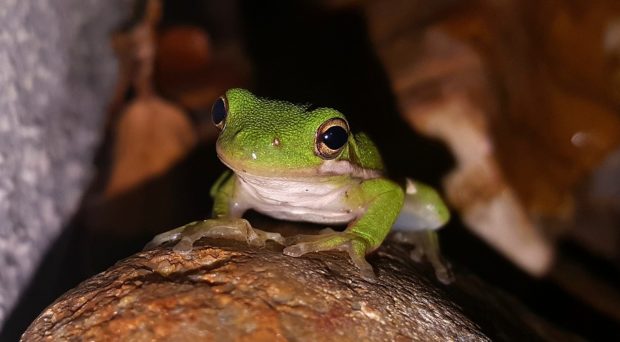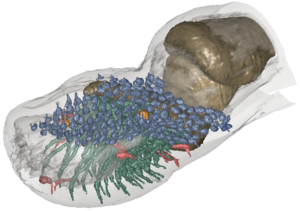Extraordinarily ordinary: Mucus glands and mucus in the sticky toes of tree frogs
Surprisingly little is known on the nature of the secreted mucus and on the morphology of the glands that produce mucus in the sticky toes of tree frogs. In this blog, Julian Langowski, corresponding author of a new article published in Frontiers in Zoology, tells us about his 3D analysis of tree frog mucus glands and exploration of mucus chemistry.

This is a guest blog by Julian Langowski of Wageningen University and Research, the Netherlands
Mucus glands and their secretions are characteristic features of amphibian skin (Fig. 1). In previous works, the mucus glands have been mostly described as relatively uniform in form and function. Also the mucus has been said to fulfil generic functions such as enabling skin breathing and lubrication.

In the sticky toes of tree frogs, however, the mucus has been suggested to play another role. Here, it may act as ‘adhesive agent’, that contributes to the remarkable attachment of these animals (see our review and previous blog entry on `Kermit’s sticky little fingers’). To advance the understanding of the functional role of the mucus in tree frog attachment, we studied the virtually unknown functional gland morphology and mucus chemistry in the toes of frogs in a comparative approach. The results of this study were recently published at Frontiers in Zoology.
A previously unrecognized mucus gland cluster in amphibians?

First, we performed a micro-CT scan (similar to the procedure you might know from the hospital) of a toe of Hyla cinerea at the Paul-Scherer-Institute, Switzerland. This allowed us to create a 3D-model of all mucus glands within that toe (Fig. 2). Already at first sight, the ventral mucus glands, which open to the pad contact surface, differ clearly in their morphology from the dorsal ones. The dorsal glands show all characteristics of ‘regular’ amphibian mucus glands (i.e. small spherical glands that are abundantly present within the skin). In contrast, the bodies of the ventral mucus glands are larger, clustered, and shifted into the inner pad volume. Could this difference in morphology mean that the ventral glands play a functional role in the attachment of tree frogs?
We were excited about our discovery of the first known mucus gland cluster in amphibians, and of an apparent morphological adaptation of the mucus glands in tree frog toes. Then, however, we found in an extensive literature screening (a) that the abnormal morphology of the ventral glands has already been described by German anatomists in the 19 th century (albeit this knowledge got lost since around 1920), and (b) that gland clustering has been depicted— but not recognized — in later literaturein a minimum of 10 families of frogs. This suggests that the toe gland cluster may be a common trait in anurans (i.e. modern frogs). Importantly, we identified gland clustering also in non-arboreal frog species that do not regularly climb and stick. This observation disagrees with the hypothesis that the toe glands are specifically adapted towards attachment.
One mucus to cover them all…
Together with colleagues from The University of Akron (Departments of Polymer Science and Biology), USA, we also characterised the chemistry of the mucus on tree frog toes. By the application of molecule-specific stains to cross-sections of the toe pads (i.e. histochemistry), we showed the presence of mucosubstances such as carbohydrates and carbohydrate-protein-complexes in the toe mucus. However, none of the 10 used stains revealed a difference between the chemical signatures of the dorsal and ventral mucus of Hyla cinerea.

A more detailed analysis of the toe mucus chemistry using spectroscopic methods confirmed our histochemical findings. Neither did we discover differences in the chemistry of mucus collected from the pads and from other body locations (Fig. 4), nor did we detect distinct variations in the mucus-spectrograms collected for two arboreal and two terrestrial species of frogs.
Overall, our study shows that the chemical composition of frog mucus is similar across body locations and species with different lifestyles, suggesting that the mucus has been largely conserved in the evolution of anurans.
To stick or not to stick…
What can we learn from these findings about the fundamentals of tree frog attachment? From an evolutionary perspective, the similarity of the mucus gland morphology and mucus chemistry between species of different lifestyles disagrees with an adaptation of the mucus gland system in the toes of tree frogs towards attachment. Instead, the gland cluster may represent a more general adaptation towards a life on land: the enlarged volume of the ventral glands compared to the dorsal ones may allow frogs to compensate for the loss of mucus by physical contact of the ventral toe surface with the environment.
Julian K.A. Langowski is a postdoctoral researcher at the Experimental Zoology Group (EZO) at Wageningen University & Research (WUR), The Netherlands. for his PhD, he studied the complex attachment system of tree frogs. Currently, he works on the fundamentals of soft biological gripping systems, and the biomimetic potential of these systems for the development of bioinspired soft robots (dutchsoftrobotics.nl). Julian’s research interests include biomimetics, bioadhesion, and biomechanics.